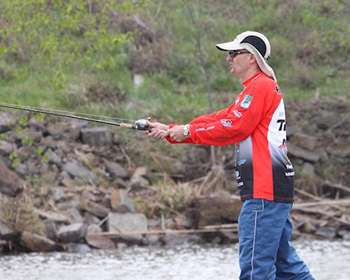
When it comes to thinking "outside the box," Bassmaster Elite Series anglers are on the cutting edge. Always looking for a competitive advantage, many pros spend hours cutting, melting, splicing and combining popular baits in an effort to discover a new way to put more bass in the boat.
Alabama pro Randy Howell has fused two popular deep water baits — a 10-inch worm and a football jig — to create a hybrid offering that catches bass from coast to coast. Rather than throw a Texas rigged 10-inch worm with a bullet weight or a skirted football jig, Howell has combined the two tactics and often throws a big worm on a bare football head jig.
He explains that, with the addition of the football head jig, a 10-inch worm crawled across the bottom closely mimics a variety of forage. "The shape of the football head keeps the worm floating and makes it look like it's feeding on the bottom," says Howell. "With a standard bullet weight, the worm has a tendency to drag flat along the bottom and not create as much commotion and action."
In addition to the increased realism, Howell's football head and worm combo casts like a bullet, allowing him to cover water and find actively feeding bass. "That's what's so great about this technique," says Howell. "You can sit way off of a point and cast a 3/8-ounce jighead into 4 feet of water and drag it all the way back to the boat.
It allows you to cover the entire depth zone." The ability to make long casts and cover water with the offering paid off for Howell when the Elite Series visited Kentucky Lake in June. On his way to a top 30 finish, Howell targeted active bass by dragging a football head-and-worm across sloping main lake points. "I caught a lot of my bass at Kentucky Lake by casting into 4 or 5 feet of water and dragging the bait into the 8- to 10-foot range," he explains.
"The majority of my bites came on long points in 6 feet of water." When it comes to bottom composition, Howell favors hard bottoms comprised of gravel and shell. "It works in brush and rock, but it really shines when fished across a rough bottom," he says. The only time Howell won't try the jig-and-worm combo is when he is fishing grass, where the shape of the football head jig catches and holds in the vegetation.
While the football combo shines during the warmest months of the year, Howell utilizes the offering from the postspawn through fall, throwing it when most other anglers reach for a standard worm or football jig. "Anywhere where you would throw a 10-inch worm, you can put it on a football head and get more bites," says Howell. "It's something that I always try because there have been times when the bites are 5-to-1 over a standard football jig or a Texas rigged worm."
Howell favors a 3/8-ounce football head jig when targeting bass in the 5- to 10-foot range and switches to a 1/2-ounce head when fishing in water deeper than 10 feet. Constant bottom contact makes the worm look like "some type of snake or creature rooting around and feeding on the bottom," he explains. Typically, Howell will have two different types of 10-inch worms rigged on football head jigs — a straight tail and a ribbontail.
While the differences between the two may appear insignificant, the results can be dramatically different. "From day to day, I've seen one outproduce the other," he says. "At Kentucky Lake, I could throw a ribbontail and catch 12-inch fish on every cast, but when I picked up the straight-tail worm, I would catch 3-pounders from the same area." While there are many different types of football jigs on the market, Howell points out that when paired with a meaty plastic, it's important to choose one with a substantial hook.
"I went through a lot of hook experimentation and settled on a big 5/0 Gamakatsu O'Shaughnessy style hook. It usually hooks them right in the top of the mouth," he explains. Currently, Howell uses a custom Lunker Lure football shaky head jig that will soon be on the market. Howell claims he rarely loses quality bass on the jig-and-worm combo because the fish often target the head of the bait, rather than the tail.
"A lot of times, the worm will be chewed up the most between the head of the jig and the hook point, so the good ones apparently see that head digging on the bottom and pounce on it," says Howell. While a Texas rigged 10-inch worm and a skirted football jig-and-craw still deserve a prominent place in the tacklebox, combining the fish-catching qualities of both baits can create a deadly offering.
"You can catch them on a worm, and you can catch them on a football jig, but there are certain times when that big worm on a football head works the best," concludes Howell.
(Provided by Z3 Media)




